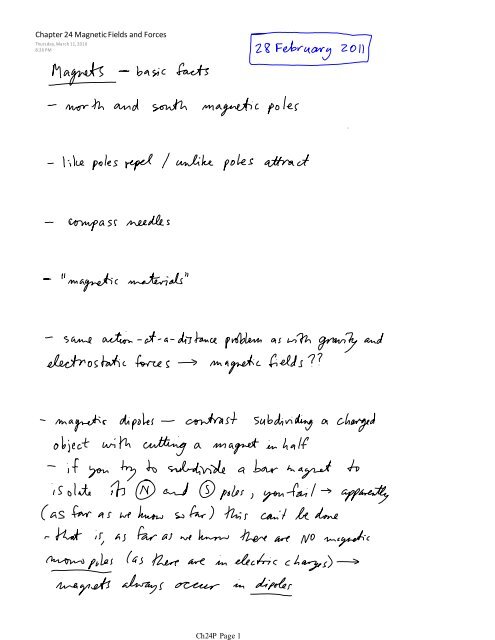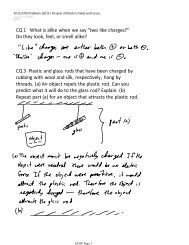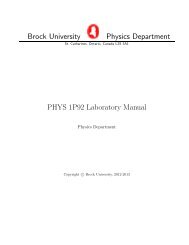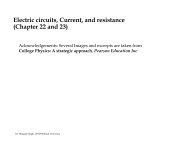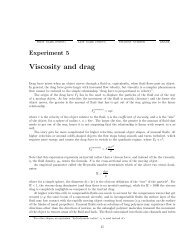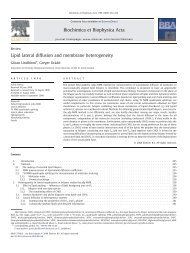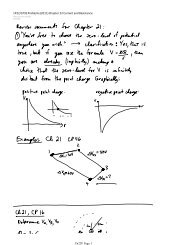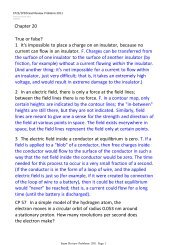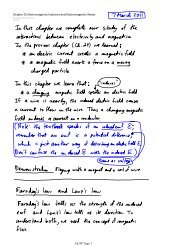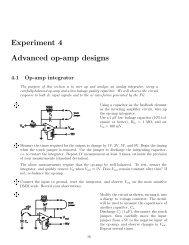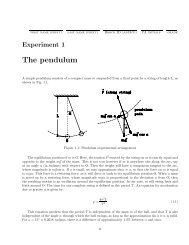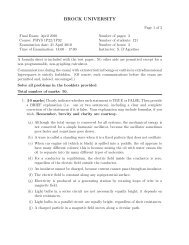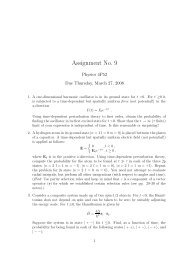Create successful ePaper yourself
Turn your PDF publications into a flip-book with our unique Google optimized e-Paper software.
Ch<strong>24</strong>P Page 1<br />
<strong>Chapter</strong> <strong>24</strong> <strong>Magnetic</strong> <strong>Fields</strong> <strong>and</strong> <strong>Forces</strong><br />
Thursday, March 11, 2010<br />
8:26 PM
Ch<strong>24</strong>P Page 2
Ch<strong>24</strong>P Page 3
Ch<strong>24</strong>P Page 4
Ch<strong>24</strong>P Page 5
Ch<strong>24</strong>P Page 6
Ch<strong>24</strong>P Page 7
Ch<strong>24</strong>P Page 8
Ch<strong>24</strong>P Page 9
Ch<strong>24</strong>P Page 10
http://electronics.howstuffworks.com/speaker5.htm<br />
Ch<strong>24</strong>P Page 11
Ch<strong>24</strong>P Page 12<br />
<strong>Magnetic</strong> <strong>Fields</strong> Exert Torques on Current Loops<br />
Copyright © 2007, Pearson Education, Inc., Publishing as Pearson Addison-W esley.<br />
Slide <strong>24</strong>-42
Ch<strong>24</strong>P Page 13
CP <strong>24</strong> Problem <strong>24</strong>.23 describes two particles that orbit<br />
the earth's magnetic field lines. Calculate the frequency of<br />
the circular orbit for (a) an electron with speed 1.0 × 10 6<br />
m/s, <strong>and</strong> (b) a proton with speed 5.0 × 10 4 m/s. (The<br />
strength of the earth's magnetic field is approximately<br />
5.0 × 10 -5 T.)<br />
Ch<strong>24</strong>P Page 14
CP 26 A mass spectrometer similar to the one in Figure <strong>24</strong>.36<br />
is designed to separate protein fragments. The fragments are<br />
ionized by the removal of a single electron, then they enter a<br />
0.80 T uniform magnetic field at a speed of 2.3 × 10 5 m/s. If a<br />
fragment has a mass that is 85 times the mass of the proton,<br />
determine the distance between the points where the ion<br />
enters <strong>and</strong> exits the magnetic field.<br />
Ch<strong>24</strong>P Page 15
Ch<strong>24</strong>P Page 16<br />
enters <strong>and</strong> exits the magnetic field.<br />
CP 45 The two 10-cm-long parallel wires in the figure are<br />
separated by 5.0 mm. For what value of the resistor R will the<br />
force between the two wires be 5.4 × 10 -5 N?
CP 47 An electron travels with a speed of 1.0 × 10 7 m/s<br />
between two parallel charged plates, as shown in the figure.<br />
The plates are separated by 1.0 cm <strong>and</strong> are charged by a 200 V<br />
battery. What magnetic field strength <strong>and</strong> direction will allow<br />
the electron to pass between the plates without being<br />
deflected?<br />
Ch<strong>24</strong>P Page 17
CP 56 A 1.0-m-long, 1.0-mm-diameter copper wire carries a<br />
current of 50.0 A towards the East. Suppose we create a<br />
magnetic field that produces an upward force on the wire<br />
exactly equal in magnitude to the wire's weight, causing the<br />
wire to "levitate." What are the magnetic field's magnitude<br />
<strong>and</strong> direction?<br />
Ch<strong>24</strong>P Page 18
Ch<strong>24</strong>P Page 19


